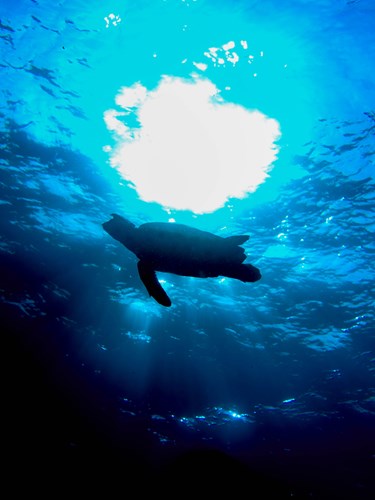Marine turtles at the crossroads
 Marine turtles are fundamental to all aspects of Indigenous culture, customs, and life in Torres Strait. While six of the world’s seven species of marine turtle are found in the region, the green turtles of the northern Great Barrier Reef population are of critical importance. Threats to the internationally significant Raine Island rookery from rising sand temperatures and saltwater inundation of nests, potentially makes alternative habitat available in the Kemer Kemer Meriam Nation vital to the future of this species.
Marine turtles are fundamental to all aspects of Indigenous culture, customs, and life in Torres Strait. While six of the world’s seven species of marine turtle are found in the region, the green turtles of the northern Great Barrier Reef population are of critical importance. Threats to the internationally significant Raine Island rookery from rising sand temperatures and saltwater inundation of nests, potentially makes alternative habitat available in the Kemer Kemer Meriam Nation vital to the future of this species.
Sea-level rise, altered weather patterns and increased sand temperatures are impacting hatchling success and leading to extreme feminisation of the population – with a major population decline predicted in coming decades. As part of the Raine Island Recovery Project, Kemer Kemer Meriam Nation Traditional Owners are working with neighbouring Wuthathi Traditional Owners, government agencies and the corporate and not-for-profit sectors to help restore turtle nesting habitat and reduce the mortality of nesting turtles. These efforts have increased viable nesting areas and hatchling success. However, despite such intervention works, drivers of change on Raine Island require additional management and conservation actions in refuge areas across Torres Strait to ensure the sustainability of our green turtles.
Regional efforts are supporting community-based management interventions to enhance hatchling success, increase the proportion of male hatchlings and reduce overall pressures on the population. Actions balance enhancing protection at existing priority conservation sites and identifying potential alternate sites aimed at ‘future- proofing’ green turtle nesting grounds in a changing climate. Turtles are highly mobile so management collaboration across their geographic range is essential to their survival. Marine turtles are at a crossroads, and a path to recovery is critical for survival of the species and Indigenous cultural values.